BOUQUET – glass bead object / holes pointillism
BOUQUET is a free-standing hole pointillism object depicting a black silhouette of a woman in crinoline holding a bouquet out of coloured glass beads. This work quotes the widely known „Olympia“ painted by Éduard Manet and was created during Artist in Residence at ZiF Centre for Interdisciplinary Research and Advance Study in Bielefeld, Germany. BOUQUET was a part of her exhibition BLAUPAUSE, which was on view in the upper foyer of the ZiF in 2016. The artist installed a site-specific work CLONES there, which created a space for further and interrelated objects ERLQUEEN, LYDIA, CUPID and BOUQUET.
Manet’s „Olympia“ shows a female nude accompanied by a black servant with a bouquet in her hands. Manet referred to the „Sleeping Venus“ first painted in 1510 by Giorgione, which became a canon in art.
All the more surprising is the fact that 300 years later in 1865 Manet’s painting caused a scandal at the Paris Salon. At that time the name Olympia stood not only for odalisque but above all as a nickname for a prostitute. Evaluating these correlations the social status of Manet’s black servant sinks even lower, namely to that of a slave of a slave of love. For Manet’s contemporaries the servant appeared just as a dark figure, almost melted into the dark background, handing a bouquet from an admirer. This self-evident degradation probably outraged no one in the Paris Salon and probably bothered also not many until the Black Lives Matter movement.
Eberhard Ortland, philosopher from ZiF Research Group on The Ethics of Copying declared in his text on BLAUPAUSE that by reducing the subject on the marginal figure of this servant, Smigla-Bobinski has „created a monument“ to the black women. Not in vain BOUQUET, the title of the work, compares the servant to a flower, which, as Mallarmé writes in his Theory of Poetry, cannot be found in any bouquet that has ever existed: „Je dis: une fleur! […] l’absente de tous bouquets“.
The artist extracted the black woman as main character out of the dark background and illuminates the figure by light shining through holes of the perforation. In fact, by drilling the holes, the artist erased the silhouette hole by hole, but at the same time created the character by that. However, it is a question of perspective and focus of the gaze, whether the figure illuminates or triggers itself. When the visual focus is set on the figure, the holes illuminate it. Looking through the figure to the background, the holes make the silhouette transparent and thus into a „blind spot“. Consequently, it depends on our behavior and focus, whether the black woman dis- or appears. Only the bouquet made by colored glass pearls placed in the holes, glow permanently. The artist uses here an ancient glass-painting technique that reached its peak in Baroque altarpieces, where lights behind colored glass balls created a mystical play of colors. The glass pearls, that came from Venetian manufactories, were regarded as a symbol of fortune and power.
Through this historically interwoven reflections, BOUQUET brings up current debates on racism, colonialism and feminism. Philosopher Manfred Frank described the work as an „extremely thoughtful, graceful and yet also insubordinate intervention in the field of the ZiF Research Group working on Genetic and Social Causes of Life Chances“.
DIG DEEPER
The Ethics of Copying – ZiF Research Group 2015-2016
Genetic and Social Causes of Life Chances – ZiF Research Group 2015-2016
Markus Schrenk’s True Copy – w/k – Zwischen Wissenschaft & Kunst
A Secret History of Women and Tattoo – Maria Lokke
He was one of the greatest of all Venetian artists, but who was Giorgione? – John-Paul Stonard, The Guardian
ART CONNECTIONS
OTHER WORDS
On „Blaupause“ by Karina Smigla-Bobinski at ZiF – Center for Interdisciplinary Research, Bielefeld University’s Institute for Advanced Study
by Eberhard Ortland, Bielefeld, translation by Saskia Bobinska
Ladies and Gentlemen, Friends of ZiF ( Centre for Interdisciplinary Research ) and art, dear colleagues,
Karina Smigla-Bobinski asked me to say a few words at the opening of her exhibition as an artist in residence here at ZIF.
I feel very honored and happy to oblige, because it gives me the opportunity to thank Karina herself (and I will come to the reason later) and the people responsible for bringing her here and making everything you see here possible: the art commission and the managment of ZIF, the University Society and the Goldbeck Foundation.
You have all witnessed how Karina Smigla-Bobinski has changed the ZiF: starting with the building itself, the dimensional structure and spatial formation of the lobby in which we are standing, to explore and yield.
A wall has been removed and instead, columns have grown in numbers. Karina is sharpening our attention for the space in which we are moving, namely the ZiF, with her interventions. It is indeed a remarkable space, the architectural one as well as the social one. Everyone who works at ZiF, who walks in and out of here on a daily basis knows that. Guests who only appear for certain events like lectures, conferences or exhibition openings, feel it too, and are happy to come back.
The change Karina Smigla-Bobinski has forced onto the existing architecture makes us reevaluate the space it occupies. This space that has been taken for granted, a room for passing through or staying, a reception area, a room for talking and meeting, has been suspended for a moment. We have to reorientate ourselves. And with that we are discovering things, that might have been there all time long, but never took our notice.
This upper lobby seems to be open in (almost) all directions. The primary entrance are the stairs, which lead up from the main entrance or the dining hall. When you climb up all the stairs from Wertherstrasse or the University you are already happy, that you have reached your destination, for most people this destination is a conference room, the Plenary Hall for example, but today the journey has ended here at the exhibition. But compared to its original state, the room appears to have expanded. You look around, catch a glimpse of the garden and the woods further up the hill through the window, or you turn to the other side and see the green, the blue and the grey over at the ZiF campus, in winter even all the way to the university.
The characteristics of this room, besides all the details that can be found when looking closer, are the ample windows, especially the glass-front to the north and south, which lets in the sunlight in the morning, midday and afternoon.
But this transparency can, at times, be overwhelming. I do not have to remind you of Heinrich von Kleist, who put his impression of Caspar David Friedrichs painting of the monk, standing all by himself at the beach under the unfathomable sky, into the following words: „it is as if ones eyelids had been cut away“1. Such an eyelid was in the 70s state of the art aluminium screen, which was placed right of the entrance, as to shield the visitors from the limitless vastness of the hall and to guide their view to the garden at first. Later on the visitors would see the space here, after changing location and orientation.
The screen divided the space into different zones. The lobby thus became the vestibule, turning the person who walked through it in different directions and perspectives. In addition, the screen with its recesses has become a multifunctional exhibition area for small to mid sized pictures, occasionally it became a sculptural object.2
Karina put an end to this. This caused some unease at ZiF. Colleagues have got to know each other better through their reaction to the changes. Something like that can happen when you invite an artist into your house!
The second significant change that Karina Smigla-Bobinski has implemented in this room is the addition of columns. I am sure that you must have noticed, that more columns are in this hall then before, and most definitely more than would be necessary to hold the ceiling. Karina has copied the concrete columns which belong to the ZiF, defining this room. Now they are accompanied by replicas, made using techniques from stage design and which were used especially to depict the pompous rooms seen in the era of Rokoko: marble pillars holding mirrors to widen the room. A wooden skeleton was covered by colored plaster. The trick here is the very subtle mimicry to concrete. Most of us would not be able to tell the columns holding the ceiling from which are mere decorative addition, at the first glance. One might call them fake. I view them as temporary sculptures perfectly fitting into the ZiF, with an intrinsic minimalistic charme and maximally withdrawn colors .
The copy forces us to look really closely as soon as we are aware of it. We see, that there are differences in the apparent non-difference.3 Just like the original columns the copies are not perfectly cylindrical but irregular tetragonals (if i counted correctly) with flat angled edges, which are reminiscent of antic pillars. Their surface is brought alive by the texture of the raw wood covered by plaster and paint, the markings on the original concrete columns are a result of the shuttering form works that were used at their making. Vertically, both original and copy, the columns are marked by rings of nails. These are a result of the nails and screws holding together the shuttering for the concrete structure, while at the copies, they are the nails fixing the wooden slats with the inner construction.
Special attention has been given to the base of each column, the sleeve made from the same original ZiF – carpet, only a little bit fresher in color than its faded patterns. Karina Smigla-Bobinski has titled her exhibition „blueprint“, thereby focusing on the topic of copy and copying, which was the most interesting area in the research team of the ethics of copying. But we have to understand, that this title is not necessarily to be taken in its literal sense. There are no cyanotypes to be seen anywhere. There is no color blue anyway. Blue is taking a break (a German pun on „Blaupause“) . Looking at it closer, the play on transformative copies and the relations of copying, in which Karina invites us , has overall little to do with blue prints or slavish reproductions, in spite of her approach to models that sometimes seems to be mimetic in nature.
We encounter an array of different objects and installations in the hall of columns, with which Karina has transformed the circumstances at the ZiF in her own powerful but subtle way.
Each of these objects by itself can be regarded as an impressively crafted item with a figurative value and room for interpretation. Some are titled and thus determined. But only when put together the ensemble reveals their meaning: They all are variations of a coherent theme, that is unfolded in very different schemes.
1. The onset of this topic in European art history is the painting of the sleeping Venus, which was painted by the Venetian renaissance painter Giorgione about 500 years ago, and which for the last 300 years, was in the collection of the Dresdner Gemäldegalerie. You all know it and you all recognized it in one of the pictures in the exhibition, but the object that on second inspection becomes strange and revealing other pictures, has nothing to do with Giorgione.

I will come back to that, but first I would like to say something concerning the iconographic and motiv-related context of this exhibition.
Just like the mysterious Giorgione, Karina addresses an educated elite audience, rehearsed in a subtile play of allusions and quotes. Like Giorgione, she is able to shape her elitist offer in such a way, that viewer, who do not share the same background in art history, who therefore do not understand all of these hints, do not feel left out, but invited to seek the deeper meaning. Well, it is an art for scientists and scholars – what means, it is just at the right place. But it is everything but too brainy, she is very sensual at her work. With a cornucopia of delightful moments she invites us to loose ourself in details, rewarding this intensive study with vast insights.
I would not be able to mention every single item of this exhibition in the time you are willing to listen to me, and of course everyone has to think and feel for him or herself while coming to the stations Karina has built for us.
But I would like to show you the red thread of the leitmotive, of its historical background. The picture of the sleeping one, who awakes soon, ( as well as her observer), appears in later versions, by Tizian, Velazquez and Manet until the image worlds of art, cinema and advertisement today.
2. In reference to the sleeping Venus, which was finished by Tizian after the early death of Giorgione in 1510, Tizian himself responds by a series of impressive Venus paintings. First and foremost in the „Venus of Urbino“ (1538) a stunning and erotic piece of art, that made its viewers uncomfortable for centuries.4
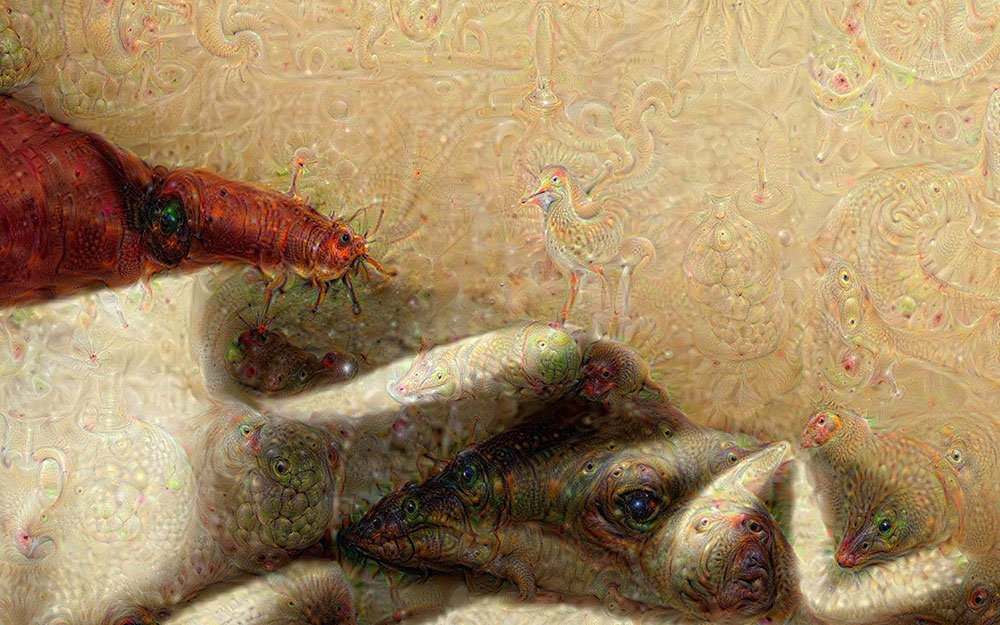 In this painting, the goddess sleeps no more, broad awake, meeting the viewers stare, inviting and conscious of her effect. She is taken out of the landscape, here she lies on a red brocade divan in front of a half closed dark green curtain in a legitimate sleeping chamber of a renaissance palace. And she is not alone, In the background two maids are occupied with the lavish gowns of the lady.
In this painting, the goddess sleeps no more, broad awake, meeting the viewers stare, inviting and conscious of her effect. She is taken out of the landscape, here she lies on a red brocade divan in front of a half closed dark green curtain in a legitimate sleeping chamber of a renaissance palace. And she is not alone, In the background two maids are occupied with the lavish gowns of the lady.
But Karina does not copy this painting, just like she does not copy this motive of the charming lying one, in all her other works, stations, here, at ZiF. It is necessary to have another look at Venus of Urbino once again, we all have seen her a lot of times. Karina extracts only one detail from the background and gives it a new twist. The hope chest in which the maid appears to look for a gown, for the Lady to get dressed decently, at Tizians painting, has turned into a arms chest through all the centuries, which interior, here at the exhibition got into a mirror cabinet.
This chest – this mirror cabinet in the chest of Venus of Urbino – is so to speak the complete exhibition in a nutshell. In the classic rhetoric this procedure can be called metalepsis: the chest is as a hyperonym for „container“, the synonym for the hope chest, then used pars pro toto as synecdoche for the painting in which has appeared, i.e. Tizians Venus of Urbino. No wonder one gets dizzy in a mirror cabinet of crossing references!
This mirror case, how impressive it might be, does not make the rest of the exhibition we are at redundant. The exhibition itself does not only portray reflexions and repetitions of the same thing, but visions of the iconography, and here, just as always the difference lies in the details.
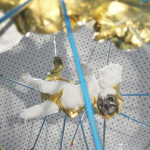 3. The mirror motif is picked up and reinforced in a series of paintings showing Venus in front of a mirror.
3. The mirror motif is picked up and reinforced in a series of paintings showing Venus in front of a mirror.
This is another branch of the modern Venus iconography established by Tizian, with its impressive figurative reflexion about form and topos of female beauty and erotic attraction.5 Karina refers especially to a painting by the royal painter Diego Velazquez from the 17. century, the „Rokeby Venus“ (1647-51), now in the London National Gallery.6 In this painting we can see the back of a lying naked woman with ivory skin, who’s face is only visible through a blurry mirror held by the childlike god Cupid.7
As before Karina does not copy the picture of the naked woman, but chooses the secondary character, the young Cupid, who is known to play carelessly with his bow and arrow. Whoever is hit by his arrow has to live with the consequences. Karina isolates him in another metaleptic move out of the context of the painting, in which he seems topically connected with Venus, takes away his mirror and arrows and turns them against him. He is presented in the plaster mould of a baroque Putto, dancing with a skull – a Vanitas motif: nascendo morimur – his back spiked with arrows like a target (or St. Sebastian). But he seems strangely unbothered by it, while he is floating above a circular mirror which is placed upon a pedistule in the style of the ZiF columns, blissfully preoccupied with his reflexion like Narciss.
4. Similarly, the painting „Olympia“ by Edouard Manet is handled by Karina. The painting itself a revival of the motif of the Venus of Urbino, refreshing and profaning, horrifying many viewers in 19th and also in 20th century.
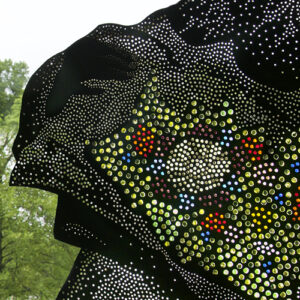
The goddess of Love has become a prostitute who self confidently lies on her bed and seems to challenge the potential customer, while she is not even notice the black maid behind her, bringing a bouquet of flowers from another admirer in her arms. The moralists of that time, who were appalled by Olympia and criticizing the sinful and immoral depiction by Manet, never mentioned the social conditions of the servants with African origins in the metropole of the Second Empire. Karina focuses on this dark skinned Maid and raises her a monument, titled (taken from Mallarmé) „L’absente de tout Bouquet“: her, who is missing in every bouquet.
5. The story of fascination for Venus figures, drafted by Karina in this exhibition, flows into the floating figure, which are depicted here on the invitation card. Yet another female body, lying overstretched but in midair.

The idea for this pose came from the movie „The skin I live in“ by Pedro Almodóvar (2011). In this movie masks and „Second-Skin“- full body suits play a significant role. In the work seen here, the white and black checked pattern causes psycho-sensual paradoxical effects: on one hand it is an absolute eye-catcher and sets off the figure in front of the background. On the other hand it hampers the sight of contours which relies on the contrast between the dark and bright, making it very difficult to form an idea of the spatial figure, checked in black and white. This is why the car industry uses it to mask prototypes in the test runs, calling these „Erlkönig“.
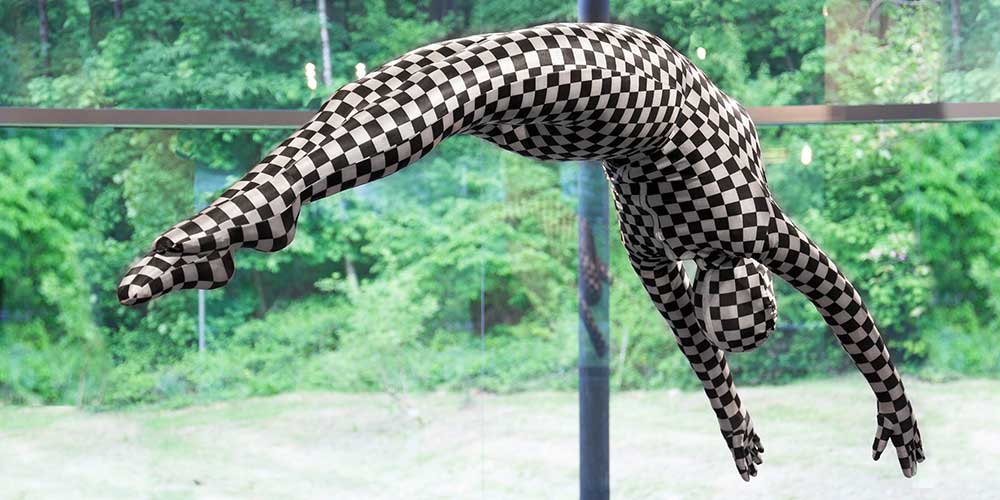 „Erlkönig“, we know all well from Goethes ballad, remains a very creepy and elusive being. Karina follows the lore of Erlkönig, which is derived from the Danish „Erllekonge“ or „Alberich“8, meaning the king of elves, anything but gentle, scary Albes, child-murdering (female) demons from the moor. A trope belonging to a very much older tradition reaching as far as the old greek Goddess Alphito9 and the old Babylonian myths and pictures of Lilith, first wife of Adam, who refused to obey her husband and from thereon roams the world as a child-murdering and men-seducing monster.10 Keeping this in mind, if I understand Karinas depictive argumentation right, the omnipresent image, in the flattered picture-culture of modern times, is the image of a erotic female, reduced to its sex appeal as a illusive promise of happiness11, makes us percept the forest of columns here at ZiF, even more spooky.
„Erlkönig“, we know all well from Goethes ballad, remains a very creepy and elusive being. Karina follows the lore of Erlkönig, which is derived from the Danish „Erllekonge“ or „Alberich“8, meaning the king of elves, anything but gentle, scary Albes, child-murdering (female) demons from the moor. A trope belonging to a very much older tradition reaching as far as the old greek Goddess Alphito9 and the old Babylonian myths and pictures of Lilith, first wife of Adam, who refused to obey her husband and from thereon roams the world as a child-murdering and men-seducing monster.10 Keeping this in mind, if I understand Karinas depictive argumentation right, the omnipresent image, in the flattered picture-culture of modern times, is the image of a erotic female, reduced to its sex appeal as a illusive promise of happiness11, makes us percept the forest of columns here at ZiF, even more spooky.
6. It is high time that we now approach on the main artwork at this exhibition. Just after the end of the stairs a strange light object is presented: silvery glimmering, illuminated by light bulbs, with white tangled cable protruding root-like into a carpet.
But this is only the backside of the piece. Its front view shows the key image of the exhibition: an enlarged partial copy of Venus by Giorgione. She is resting on her pillow, her sheet, but the background above her is cut out around the edges of her lying shape. The closer one gets to the picture, the more one discovers a terrifying swarm of birds, reptiles, insects and mythical creatures, which inhabit her body as well as the pillow, the greenery beneath her.
The copied image of a woman is superimposed and permeated by a microstructure of animal and demonic figures, illustrating with one stroke the ancient Greeks experience, which was summarized by Thales of Millet. that “everything“ is „full of Gods“12 or „full of Demons“13. But how did they permeate the picture? It is an effect which is almost autonomously created by a image recognition software by the name of Deep Dream.14
An artificial neural network was programmed to analyze features of a digital copy of a picture searching for distinctive patterns and statistically comparing the color, light and shadow distributions, which then is run through a data bank of previously known pictures and their patterns. The results are crucial for information processes like face recognition softwares.
Wherever the system finds in its database something fitting to the given parameter, the „known“ shape gets „recognized“ in an „unknown“ pattern15 somewhere and pasted in the relevant position again. This operation repeated frequently enough, leads such a psychedelic melee of images, like the one animated by Deep Dream, into the Image screen of the sleeping Venus.
This artificial intelligence demonstrates this way what, according to Goyas concerning insight about the human mind and especially, loaded with great expectations reason of society holds true: El sueño de la razón produce monstruos.16
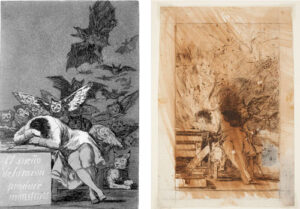 The Sleep of Reason Produces Monsters – The dream or sleep of reason – the dreaming reason or the dream of the reason – gives birth to monsters; a fortiori the dreaming artificial intelligence. The software and the images it generates give us a new opportunity to watch and maybe understand the process of creating the unnerving weirdness in the world.
The Sleep of Reason Produces Monsters – The dream or sleep of reason – the dreaming reason or the dream of the reason – gives birth to monsters; a fortiori the dreaming artificial intelligence. The software and the images it generates give us a new opportunity to watch and maybe understand the process of creating the unnerving weirdness in the world.
Karina gave the name “Lydia“ to this piece and reminds thus on the tattooed woman, famous hundred years ago, unforgettably sung17 about by Groucho Marx in „At the Circus“ in 1939, belonging to a showman profession. „Lydia, the Tattooed Lady“, „Lydia the Queen of Tattoo, Lydia, the picture encyclopedia“, the old skin, on which everything is archived18, what matters, everything what entice, or frightens us.
Now, I have already spoken too long. Thank you for your patience and attention. I wish you and us and animating evening at this exhibition, in conversation with the pictures and one another and the art.
…
1 > Heinrich von Kleist, „Empfindungen vor Friedrichs Seelandschaft“ (1810), in: ders., Sämtliche Werke und Briefe, hg.v. H. Sembdner, München 1982, Bd. 3, 327.
2 > http://www.uni-bielefeld.de/%28de%29/ZIF/Kunst/2015/06-14-Wicker.html
3 > Vgl. Nelson Goodman, Languages of Art, Indianapolis 21976, 99-111.
4 > Vgl. z.B. aus das kategorische Urteil von Mark Twain [Samuel L. Clemens], A Tramp Abroad, Hartford, Conn., 1880, p. 231: „the foulest, the vilest, the obscenest picture the world possesses“. – Nach allem, was wir wissen, handelte es sich bei dem Bild, das der spätere Herzog von Urbino, Guidobaldo della Rovere (1514-1574) als Geschenk für seine minderjährige Braut bestellt hatte (Giulia Varano [1524-1547] war bei ihrer Hochzeit 1534 erst zehn Jahre alt), um ein Stück der éducation sentimentale, des Brautunterrichts in elementaren Belangen der ehelichen Liebe. Zur kontroversen Rezeptionsgeschichte und zum aktuellen Forschungsstand vgl. das Lehrmaterial zum Kurs „Art History 213: History of Italian Renaissance Art“ der State University of New York at Oneonta von Allen Farber (2014), http://employees.oneonta.edu/farberas/arth/arth213/Titian_Venus_urbino.html (abgerufen 16. 5. 2016).
5 > Vgl. u.a. Tizians Venus with a Mirror (ca. 1555), National Gallery of Art, Washington D.C.
6 > Oliver Waldherr, „Die grössten Vandalismus-Vorfälle der Kunst“, GoldeneAnanas.com (28. März 2015),erinnert daran, daß die Rokeby-Venus in der Londoner National Gallery bereits 1914 zum Gegenstand einerfeministisch motivierten ikonoklastischen Attacke wurde: „1914 brachte Mary Richardson eine Axt in dasMuseum und schlug 7 x auf das Gemälde ein. Später begründete sie Ihre Tat damit, dass es sie irritiert hätte, wiealle Männer immer auf diese nackte perfekte Frau starrten.“ <http://goldeneananas.com/?p=1020> (mit Abb. desbeschädigten Gemäldes; abgerufen 16. Mai 2016). – Wenn von den Spuren dieser Beschädigung an dem heute inder National Gallery ausgestellten Bild nichts mehr zu sehen ist, so ist dies einer gründlichen Restaurierung zuverdanken: Einer Kopie des Originals, mit der das beschädigte und geflickte Original überdeckt wurde.
7 > In der präzisen Abstufung scharf und unscharf gesehener Zonen des Bildraums erweist sich Velázquez einmal mehr als überragender Wahrnehmungsphysiologe und –psychologe: Sein Bild ist bereits eine ausgearbeitete Reflexion über den männlichen Blick und keineswegs bloß ein plumper Appell an die zu erwartenden Reflexe des Publikums.
8 > Vgl. Burkhard Schröder, „Die Erlkönigin“, Telepolis (9. 6. 2002), http://www.heise.de/tp/artikel/12/12692/1.html, aktualisierte Fassung v. 11. 2. 2008 unter http://www.burks.de/burksblog/2008/02/11/die-erlkonigin (abgerufen 17. 5. 2016).
9 > Göttin der Gerste, aber wohl auch des Mutterkorns, mit entsprechenden Zuständen; vgl. Schröder, ebd., gestützt auf Ailia Athena, „The Greek Goddesses“, http://www.paleothea.com/Goddesses.html (abgerufen 17. 5. 2016).
10 > Schröder, ebd., gestützt auf Robert Graves / Raphael Patai, The Hebrew Myths, New York 1964, 65-69; vgl. a. Raphael Patai, The Hebrew Goddess, Detroit 31978
11 > Vgl. Winfried Menninghaus, Das Versprechen der Schönheit, Frankfurt a. M. 2007. Rückseite von „Lydia“ im Foyer des ZIFs „Schlummernden Venus“ von Giorgione
12 > Vgl. Diels/Kranz, Die Fragmente der Vorsokratiker, Bd. I, Zürich/Berlin 111964, 79, Thales, A 22 (= Aristoteles, de anima A 5, 411 a 7): „pánta pl?re theõn“.
13 > Ebd., S. 68, Thales A 1 (= Diogenes Laertius I 27): „daimón?n pl?re“.
14 > http://deepdreamgenerator.com
15 > Vgl. Mark Gibbs, „Deep Dream: Artificial intelligence meets hallucinations“, Networkworld (Aug 23, 2015), http://www.networkworld.com/article/2974718/software/deep-dream-artificial-intelligence-meetshallucinations. html (abgerufen 17. 5. 2016).
16 > Francisco de Goya y Lucientes, Caprichos. Introduced and Edited by M. Mícko, London u. a. 1958, Nr. 43.
17 > https://www.youtube.com/watch?v=uVBBxptpSY8: „Lydia oh Lydia, that encyclopedia, Oh Lydia the Queen of Tatoo. On her back is the Battle of Waterloo. Beside it the wreck of the Hesperus, too. And proudly above waves the Red, White, and Blue, You can learn a lot from Lydia.“
18 > Vgl. Nikki, „Lydia the Tattooed Lady“, india ink elephant (May 14, 2011)., https://indiainkelephant.wordpress.com/2011/05/14/friday-ephemera-lydia-the-tattooed-lady (Abruf 18. 5. 2016)
…
Dr. Eberhard Ortland is a Fellow of the Research Group Ethics of Copying at ZiF Bielefeld. He studied Philosophy, Art History and Literature in Bochum, Berlin (FU) and Kyoto; Doctoral thesis on philosophical aesthetics as „Doctrine of Perception“ at the University of Potsdam. He was a research assistant at the University of Hildesheim from 2007 to 2014 and editor of the Allgemeine Zeitschrift für Philosophie.
* *** *
Interventionen mit dem Zauberstab der Analogie
by Prof. Dr. Dres. h. c. i. R. Manfred Frank
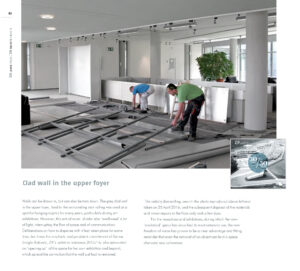 Karina Smigla Bobinski ist für die Periode 2015/16 „Artist in Residence“ am Bielefelder ZiF: ein Glücksfall! Keine bessere Wahl hätte die Leitung des ZiF treffen können. Die Künstlerin soll – so die Idee – durch „Eigensinn, Widerständigkeit und Dissens“, unter Einsatz der Mittel ihrer Kunst, belebend einwirken auf das ZiF im Allgemeinen und be sonders auf die Binnendiskussionen zweier ZiF-Forschungsgruppen, an denen sie leidenschaftlich teilnimmt. Eine ist befasst mit der Ethik des Kopierens, die andere mit den genetischen und sozialen Ursachen von Lebenschancen.
Karina Smigla Bobinski ist für die Periode 2015/16 „Artist in Residence“ am Bielefelder ZiF: ein Glücksfall! Keine bessere Wahl hätte die Leitung des ZiF treffen können. Die Künstlerin soll – so die Idee – durch „Eigensinn, Widerständigkeit und Dissens“, unter Einsatz der Mittel ihrer Kunst, belebend einwirken auf das ZiF im Allgemeinen und be sonders auf die Binnendiskussionen zweier ZiF-Forschungsgruppen, an denen sie leidenschaftlich teilnimmt. Eine ist befasst mit der Ethik des Kopierens, die andere mit den genetischen und sozialen Ursachen von Lebenschancen.
Karinas Kunst und Können sind so vielgestaltig, dass ich an der Aufgabe verzweifle, sie auf kurzem Raum zu charakterisieren. Gern geht ihr das Wort ‚Interaktion’ über die Lippen. Ihre Kunst-Gegenstände – mit modernsten, oft elektronischen Mitteln erstellt – haben nur die halbe Arbeit getan; die andere Hälfte fällt dem Rezipienten zu, der sich vom passiven Beschauer zum mitspielenden Kollaborateur wandelt. Wie die Ballfängerin in Rilkes Gedicht, die nicht bloß immer „Selbstgeworfenes fängt“, sondern den Ball einer fremden fernen Mitspielerin: „Erst dann ist Fangen-Können ein Vermögen.“ Das bekannteste Beispiel ist ADA, der heliumgefüllte und Malstifte-bewehrte Ballon, der in einem leeren weißen Raum durch Stoß und Widerstand der Hallenbesucher die wunderlichsten, von keiner Absicht antizipierbaren Zeichnungen hinterlässt. Kunst ist „absichtliche Zufallsproduktion“, ha tte Novalis gesagt. Von ihm stammt auch der Gedanke, der Leser müsse der „erweiterte Autor“ sein. „Er ist die höhere Instanz, die die Sache von der niedern Instanz schon vorgearbeitet erhält.“
Ein anderer Lieblingsbegriff der Künstlerin ist ‚Intervention’. Intervenierend greift sie in bestehende Zusammenhänge ein. Ihr Wirkungsfeld ist nicht die entrückte Galerie, das tempelartige Museum, sondern der alltägliche Lebens- und Arbeitsraum, z. B. die Halle im ersten Stockwerk des ZiF, den sie von der hässlichen Trennwand befreit und mit dem Zauberstab von Copy and Paste in eine stoische Säulen- oder peripatetische Wandelhalle verdoppelt, die zu unendlichem Gespräch und Austausch zwischen Wissenschaft und Kunst einlädt und von der sich das ZiF nie mehr trennen sollte. – Diese Manipulation passt nicht nur zum Gegenstand der Forschungsgruppe „Ethik des Kopierens“, sondern setzt auch die alte Einsicht ins Bild, dass „absolut neu keine neu geschaffene Form ist“. Sie findet sich in Schleiermachers Hermeneutik und macht uns aufmerksam auf die Unmöglichkeit, in unseren Kreationen auf absolut jungfräulichen Rohstoff zu treffen: Immer schon greifen wir Worte und Zeug auf, das andere schon benutzt haben; aber wir kombinieren es günstigenfalls zu neuen Fügungen und sagen, denken und bauen Dinge, die keiner zuvor gesagt, gedacht, erstellt hat.
Auch als einen Wald, z. B. den Zauberwald von Breziljan, kann man die Wandelhalle ansehen. „Wie man in ihn hineinruft, so schallt es heraus“. Und plötzlich öffnet sich der zweite Schauplatz der Ausstellung: Giorgiones unvollendet liegende Venus wurde von vielen Künstlern kopiert und ausphantasiert. Vielleicht stammt die merkwürdig plumpe linke Hand, die die Scham bedeckt, nicht von Giorgione, sondern von einem dieser Bearbeiter. Die Unförmigkeit dieser Hand verführt Karina, sie mit der herbeigegoogelten Fältelhaut und den zueinander gewanderten Glubschaugen von Plattfischen und anderen Kreaturen zu spicken. –
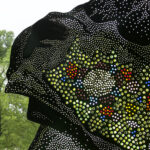
Manets Kopie erregte Empörung, aber nicht, weil er der Venus eine rassistische Vorurteile bedienende „Negersklavin“ zur Seite stellte, sondern weil er die Venus als gewöhnliche Pariser Hure malte. Diese Afrikanerin löst Karina aus dem Hintergrund des Gemäldes heraus und versetzt sie ins Zentrum, ja lässt sie erstrahlen im Perlenglanz von Glaskügelchen, die ihr Gewand nach Art rückseitig beleuchteter barocker Perlenaltäre aus böhmisch-bayerischer Synergie eingelegt sind: eine äußerst durchdachte, anmutige und doch auch aufmüpfige Intervention in die Arbeit der Forschungsgruppe über genetische oder soziale Vorgaben von Lebenschancen.
Ich glaube, der „Widerspruch“ gegen Karinas Interventionen wird sich in Grenzen halten. Das ZiF und seine geistvollen Forscher(innen) und Besucher(innen) werden begeistert sein über den Glanz, in dem ihre zweckmäßig-nüchterne Halle diesmal erstrahlt, und sich nur wünschen, sie möge nie wieder in ihr alltägliches Aschenputtel-Design zurückfallen.
* *** *
Artist text on the entry of the ZiF Residency
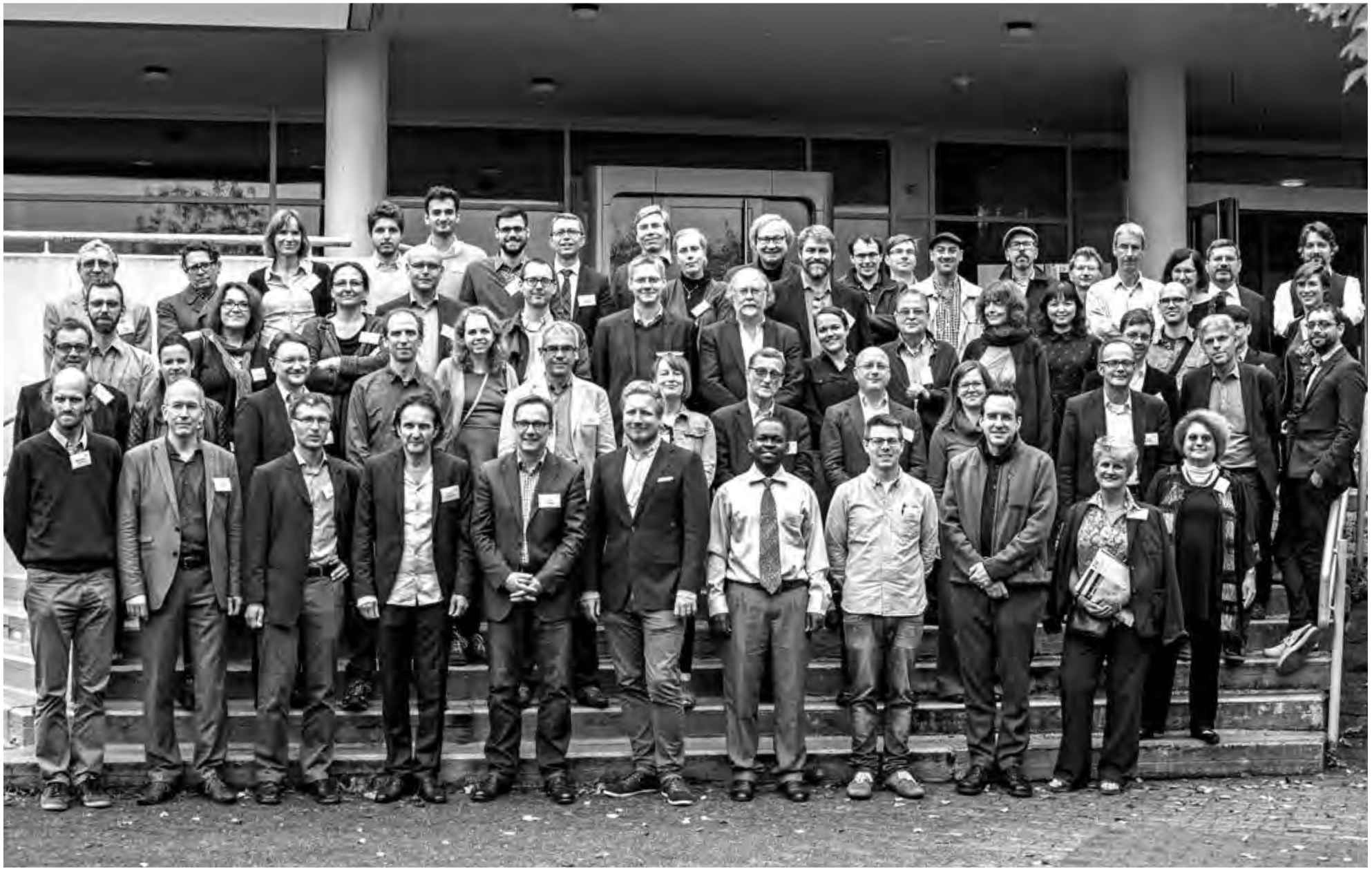 Science and art are systems of knowledge about the essential properties, causal connections and regularities of nature, society and thought, which are condensed into statements, theories and hypotheses, but which demonstrate themselves with different focus and form. Actually, both disciplines ask the same questions, they just have different perspectives on them. Both sides are curious and creative. From this point of view, I see artists as researchers and scientists as creative minds.
Science and art are systems of knowledge about the essential properties, causal connections and regularities of nature, society and thought, which are condensed into statements, theories and hypotheses, but which demonstrate themselves with different focus and form. Actually, both disciplines ask the same questions, they just have different perspectives on them. Both sides are curious and creative. From this point of view, I see artists as researchers and scientists as creative minds.
Our methods are: observation, abduction, refinement, deduction, testing and experimentation, confirmation or falsification, releasing. The differencies? Science work with objective logic and ask for replicability. Art is unlogic and look for subjective uniqueness.
However, we all try to understand what is happening outside the black box of the body. Sometimes we look outwards and position ourselves in relation to others. Other times we look inwards and examine our perception and consciousness. Based on this, I make art to create an osmosis with the world and to enter into a dialogue with others about it, where the flow of information happens not only in one direction (artist > work > viewer), but, thanks to the interactive nature of my works, influence each other (artist <> work <> viewer) and even let something new emerge from it. Therefore, my artworks are materialised stations / results of my thoughts and inventories of my interactions.
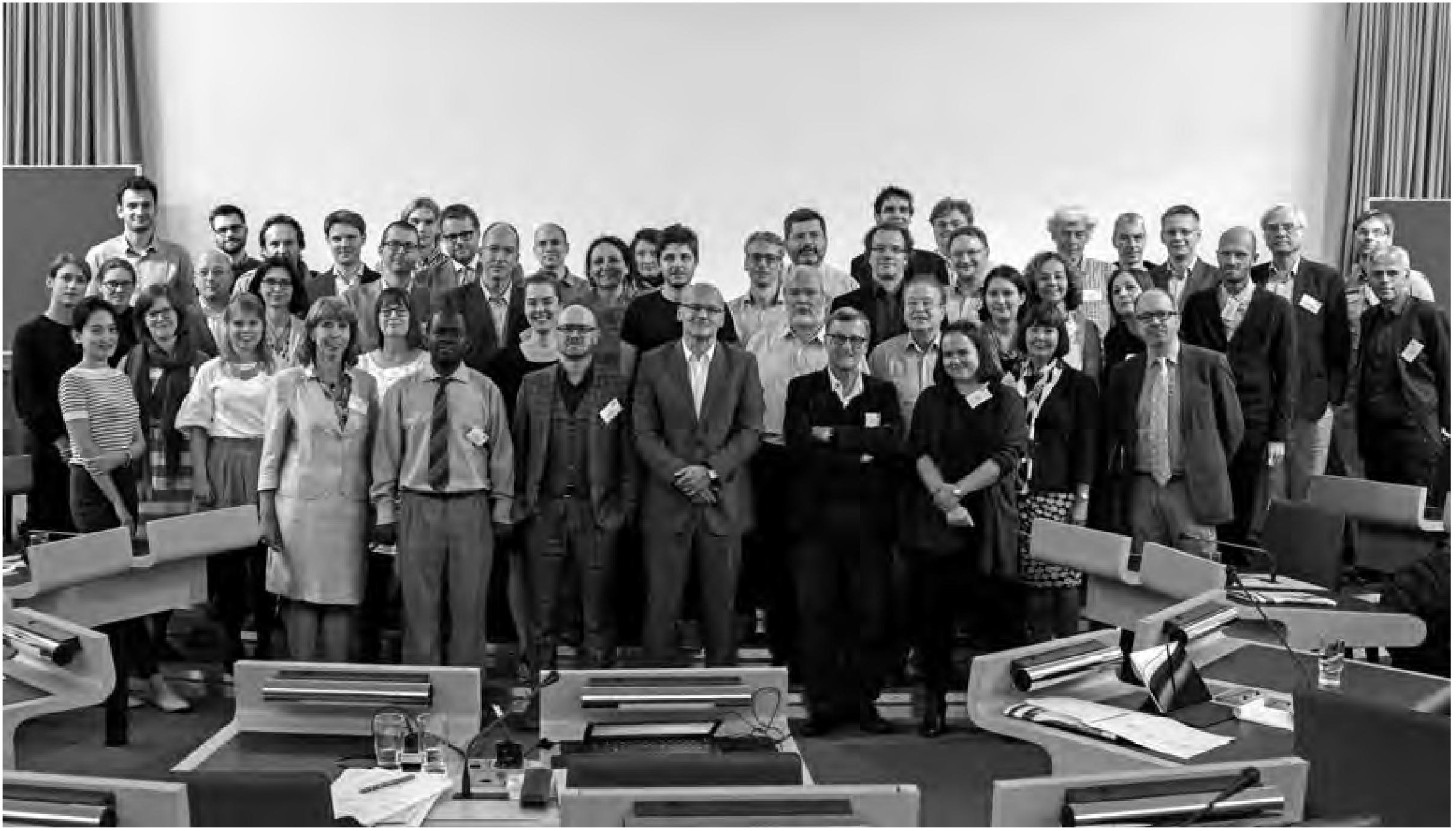 Therefore, I will not start my residency with a finished concept, but let the idea emerge and develop in exchange and dialogue with the two research groups. My head is full of ideas that are just waiting to be developed and realised. However, one thing in particular is the focus of my interest, it is the aspect of copying, which is relevant for both ZiF research groups and which has already been thematised from different perspectives in my works, such as ALIAS, JOSS, ADA, SIMULACRA or the recently created game installation „The Brain Game“.
Therefore, I will not start my residency with a finished concept, but let the idea emerge and develop in exchange and dialogue with the two research groups. My head is full of ideas that are just waiting to be developed and realised. However, one thing in particular is the focus of my interest, it is the aspect of copying, which is relevant for both ZiF research groups and which has already been thematised from different perspectives in my works, such as ALIAS, JOSS, ADA, SIMULACRA or the recently created game installation „The Brain Game“.
I have already had the good fortune to visite Dr. Eberhard Ortland from the research group „Ethics of Copying“ and Dr. Jonas Rees from the research group „Genetic and Social Causes of Life Chances“ at the ZiF and I am really excited about how unproblematic, exciting and informative our conversation went! I can hardly wait to get started!
* *** *
TECHNICAL SPECIFICATIONS
Description > glass bead object / holes pointillism
Components > PVC panel, glass bead, gold, paint
Dimensions > 1,7 m x 1,2 m
Premiere > 2016, ZiF Center for Interdisciplinary Research, Bielefeld University’s Institute for Advanced Study, Germay
Supported by

